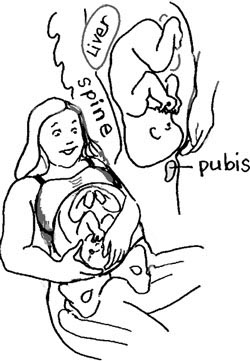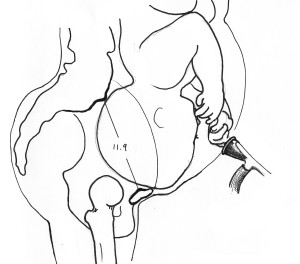
First babies may engage by 39 weeks of pregnancy. Subsequent babies may engage before labor begins, or will usually engage with early labor contractions. For an easier birth, baby will engage as labor gets established.
Engagement means the widest part of the baby’s head has dipped below the entrance to the pelvis (the brim). Standing and allowing the belly to hang forward (lordosis) keeps the brim open enough for the average baby in the average pelvis to engage nicely.
A baby cannot get through the pelvis without first getting into the pelvis! Lack of engagement is a common issue for the laboring woman whose baby remains high in the pelvis. In roughly half the cases, the uterus gets overworked while trying for days to get baby into the pelvis. A common obstetrical solution is to do a cesarean.
Spinning Babies® offers a simple alternative. We base our approach on what the body needs. To help baby, add body balance with techniques here at Spinning Babies® or with a body worker.
Engagement techniques can be done in labor over the course of an hour or so. Some are easy to do, while others are a bit more challenging. But once they are done, the labor is very likely to progress and progress sometimes quickly. And sometimes, the labor will even finish quite suddenly with less pain than before the engagement. In fact, learning how to help the baby engage can save hours and even days of labor.

Early labor can go on for a day or more, and sometimes the woman begins to think her starter is broken. This is because the labor can start and stop as the baby tries to get into the pelvic brim. Women may not dilate beyond 3 cm when the baby remains high. Labor can feel so strong as the uterus works hard to rotate the baby’s head to drop into the pelvis. These strong contractions can go on for days.
Once the baby engages, labor becomes much more effective and the baby is usually born in 8 hours or less. Other times, labor seems to begin and progress normally until a labor stall occurs in active labor. The baby remains high during the stall in this case. Not all unengaged labors have these characteristics, but these are quite common.
You’d want to focus on engagement if the baby is at -2 or -3 station AND the labor didn’t progress within a few hours of regular contractions. You could also try the following techniques if the early labor felt strong but had a start and stop pattern (with strong contractions):
Again, our goal is to help the baby rotate to the LOT, LOA, or OA fetal positions so the head fits more readily. We also want to help the baby tuck his chin with the abdominal lift and with circles on a birthing ball.
Once the baby engages, perhaps because the baby rotated and dropped into the pelvis, the labor often seems to stall. In this case, there is no problem as the uterus is simply resting. The mother can rest too, as long as her and her baby’s vital signs are good. Once the uterus is rested and the mother has eaten and slept, the labor will pick up again.
It won’t seem as painful when it starts up again, and the contractions will be more manageable this time around. The contractions will then get closer and longer lasting, and the cervix will open in response. Things will be more predictable when the baby’s chin is tucked and the head fits in the pelvis better.
Note: When the cervix is fully open and you find the baby is still high at the -3 station, your techniques to engage the baby may bring the baby all the way through the pelvis in a very short time. Be ready!
The baby can sometimes get stalled on another part of the pelvis. If the baby drops but the chin remains up, though the baby is coming down, the labor might still take a long time, depending on the pelvic shape.
We may then have to help open the mid-pelvis (ischial spines) and outlet. If the baby is at -1, 0, or +1 station, then the baby is engaged but stuck in the mid-pelvis. You should do a Side-lying Release followed by side lunges for either a Transverse Arrest or an Asynclitic baby.
The lunge is a wonderful technique for helping the baby when labor stalls at 0 station or below. If the baby drops but the head is tipped, as if the baby is listening to the outside world (in an asynclitic position), then the labor will remain long. Applying these techniques should help to open the mid-pelvis and allow the head to pass through.
Babies naturally engage in the pelvis when the birth anatomy is balanced. Contractions can help if the broad ligament is soft and the brim is open enough. Fetal chin tucking and coming down from the mother’s left side helps more babies fit into their mother’s inlets.
Generally, we hope for flexion and rotation before engagement. This is most important when we find the baby to be in the posterior position and high after 38 weeks. Dip the hip may be a good, specific technique to address this.
Work on balance before rotation and descent, even though sometimes we have a time issue, as when a woman’s membranes have released and her provider has a time limit for her labor. Descent from a non-optimal position may have additional challenges that may be met with maternal positioning and activities in labor. Doing balancing activities first will ease the approaching phase of active labor.
For additional education to even further enhance your pregnancy and labor preparation, shop our extensive collection of digital downloads, videos, DVDs, workbooks, and more.